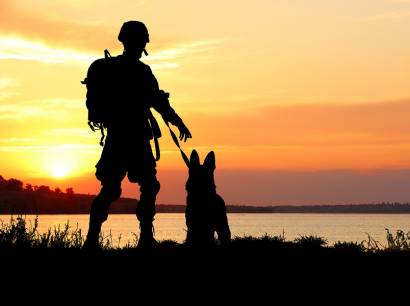This Week's Story
subscribe to podcast [click here] or play audio below
Stubby sometimes waited with a man until he could be rescued; sometimes he stayed with a man until he died.

This Week’s Story relives American history and the Bible through brief inspiring stories presented on mp3 audio recordings and text for reading.
Stubby: from War Zone to Presidents, part three
“Two of our companies have been under attack for eighteen hours and cut off from the rest of the regiment. I want Headquarters company on the lines,” Colonel Parker ordered.
Soon Stubby, mascot for the 102nd Infantry, and his master Conroy were in trenches with other Allied soldiers. German artillery fire sliced the air and pounded the ground. Conroy heard the loud popping noise of German guns shooting Minnie shells. Each weighed fifty pounds. They looked like monstrous footballs as they arced in the air before falling to the ground and exploding.
Allied guns roared. Some were mounted on flatbed railway cars. Usually Stubby could hear incoming rounds from the enemy before humans could. As each new barrage began, he would bark an alarm. If he smelled poisonous gas from a canister the Germans fired into the troops, he barked an alarm.
When the enemy began retreating, he went onto the battlefield. A shell exploded and pieces of metal hit him in the chest. Conroy crawled from a trench and rescued Stubby.
Conroy carried his beloved dog to a regimental doctor who ordered, “Put him into an ambulance.” Wounded soldiers lay beside Stubby.
For six weeks he was in a hospital recovering. In June he rejoined Conroy and the 102nd Regiment of the United States’ 26th Yankee Division. The Division had been fighting on battlefronts since the beginning of February.
Allied troops were pouring into France. By July 1918 they were pushing the Germans back. They began taking prisoners of war. Conroy was with an intelligence unit that handled identification and security of German soldiers.
Stubby was ideal for this work. He could recognize enemy soldiers by sight and smell. He knew their clothing. When they were captured, he would walk alongside them and bark or bite to keep them cooperating.
When bodies were lying on battlefields, he would find the Allied wounded and lead medics to them. Sometimes he waited with a man until he could be rescued, or he stayed with a dying man until he died.
During the Meuse-Argonne campaign which was filled with rain, mud, shelling, and death, Stubby captured a German soldier. When he tried to run, Stubby knocked him down. He sunk his teeth into the seat of the soldier’s pants and would not let go until more help came.
November 11, 1918 a cease-fire was declared. Hundreds of Conroy’s friends gathered around their mascot. Some said that Stubby had brought victory. One wrote about Stubby:
“He is a fighting bulldog of the old Yankee Division.
And is the joy and pride of our company.
When we take him back to the U. S. A.,
Stubby will hold the stage,
Night and day.”
Christmas Day of 1918 President Woodrow Wilson met Stubby and shook his paw. Stubby was honored with medals, stripes, and service bars. He became known as Sergeant Stubby. He was introduced to two more presidents. General Pershing pinned a gold medal onto Stubby’s jacket. In 1926 Stubby died at age eleven or twelve.
In the hellishness of World War I Stubby and many other dogs brought comfort and help to soldiers.
This is Barbara Steiner inviting you to enjoy thisweeksstory.com.
<< previous story] [next story >>
We invite your comments! [click here to comment]
This Week's Story is a non-profit supported by listeners. [click here to make a donation]
